Online Resources: 1939 Register
- 7th May 2020
With VE day tomorrow we thought we’d share about the 1939 Register, available to search via Ancestry & Find My Past. With the current guidance to stay at home we spoke to both companies who have allowed free access at home.
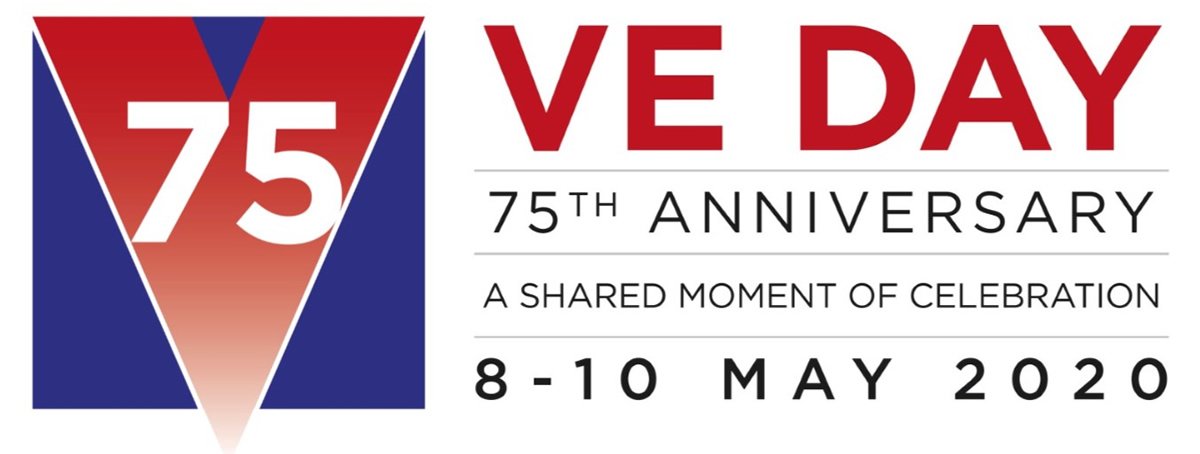
What is the 1939 Register?
It is a register of civilian population in England & Wales on 29 September 1939. It was produced to enable ID cards to be issued and ration cards. It was later used for administering conscription and other purposes.
What does the 1939 Register contain?
Over 40 million people are included on the Register. It was set up using the plans for the 1941 census (which was never taken), and the information taken is similar but slightly different to what you’d find on the census. Only civilians or members of armed forces at home on leave are included.
- address
- surname
- first name(s)
- role (for institutions only – Officer, Visitor, Servant, Patient, Inmate)
- gender
- date of birth
- marital status
- occupation

VE Day
What can I See?
The original books have been digitised and can be seen online.
Only the record of people who would be over 100 years old or were known to have died are visible. So for instance the Dad of Paul, our Outreach Manager, is on there but blanked out, as he is 81, like most people who were children at the time.
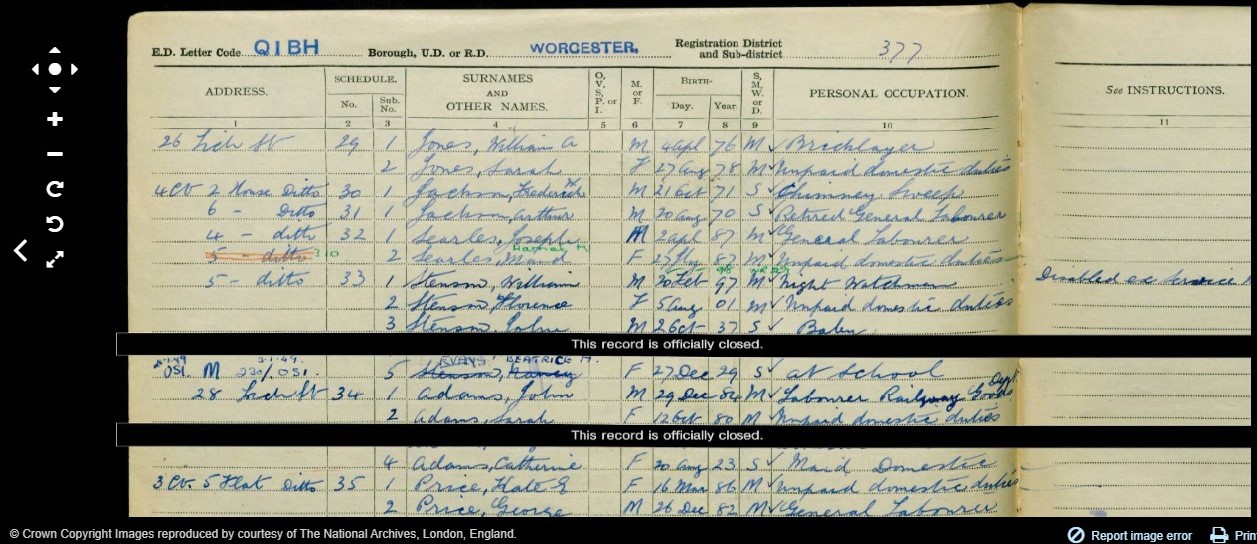
Page for Lich St, Worcester, from Find My Past website
I Can’t Find Someone!
Were they a civilian, living in England or Wales in September 1939? If not they won’t be on.
Mistranscribed – like many online sources the person typing it up may have misread the handwriting or mistyped, and since this is what you are searching you may not find what you are looking for. For instance, Paul’s Auntie Doreen is shown on the Register, although as she was under 100 and still alive she should have been blanked out. Checking this out it seems her birth year was entered as 1913 not 1933, as entered in the register. Some registers, as they handled for many years, show wear and tear so may have been hard to read.
Details not as you expect –
- were they down under a different name than people called them (e.g. Aunt Sally down as Sarah, Billy as William, or known by middle name).
- Have you got the right age?
- Where they living somewhere else at the time? Evacuation had begun, and seasonal workers may be in another part of the county or country.
You may have to widen your search. The person entering the details may have spelt the information wrong or misheard.
As the results are ranked like internet search engines, entries which are a little different should still come up further down the list, unless you’re searching for a very common name.
A tiny number of books didn’t survive.
If you can’t find someone try searching for someone else in the household and leaving out different parts of the information you have in turn.
Searching By Address
On Find My Past you can search by street, entering it in ‘Keywords’ box. That assumes street names correctly written though. However it means you can see what living in a property then, as well as using it for family history.
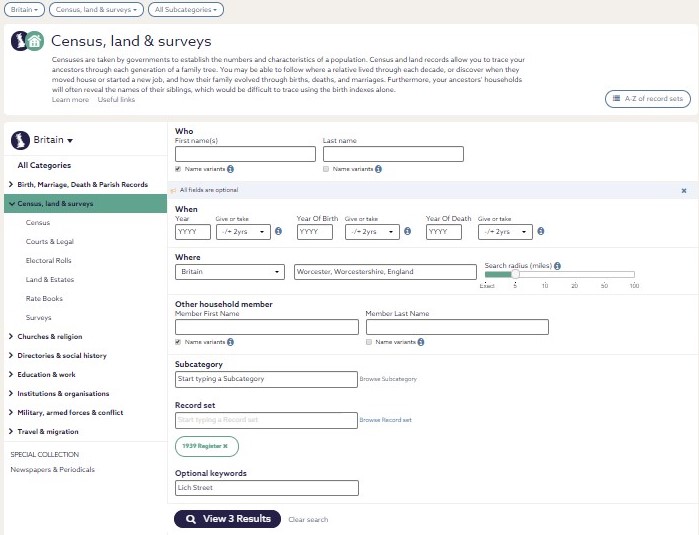
Find My Past search screen, set up for searching for someone in Lich Street, Worcester
Post War
The Registers were transferred to the NHS which it began, and became the NHS Register. Details was updated for several years, so you can find additions into the 1950s. For instance Paul’s Auntie Doreen’s married name is added, event though the wedding took place in the mid 1950s.
How do I access 1939 Register?
Both Ancestry and Find My Past, commercial family history websites, have got the 1939 Register on their site which you can search. Normally you can search these for free in The Hive, as we provide access. With the current situation we’ve spoken to both companies and they are allowing our members free access at home whilst we have to stay at home.
Find My Past
The 1939 Register is on their Census section. Enter 1939 into the Record Set box to narrow it down
You need a user name and password to access the website. Email explorethepast@worcestershire.gov.uk with your library card number and we will send you details.
To avoid it being taken advantage of there are daily and monthly limits on how many records can be accessed.

Ancestry
Ancestry has over 24 billion records from across the world, so narrowing down is important to avoid being overwhelmed by irrelevant records. The 1939 Register can be searched separately by searching it in their card catalog, or else under Census section.
Ancestry is currently available to those with Worcestershire Library cards via the County Council website.
Go to the website http://www.worcestershire.gov.uk/info/20017/libraries/1036/my_library_account_and_pin and log in using your 8 digit Library card number and 4 digit PIN (usually first 4 digits of your date of birth).
Then go to the Home Page (click on House) and use the link on the right, or else go to http://www.worcestershire.gov.uk/info/20303/eresources_and_online_information/322/a_to_z_of_e-resources
When you click on it it should say Worcestershire in the top right hand corner, and it shouldn’t ask you for any money.
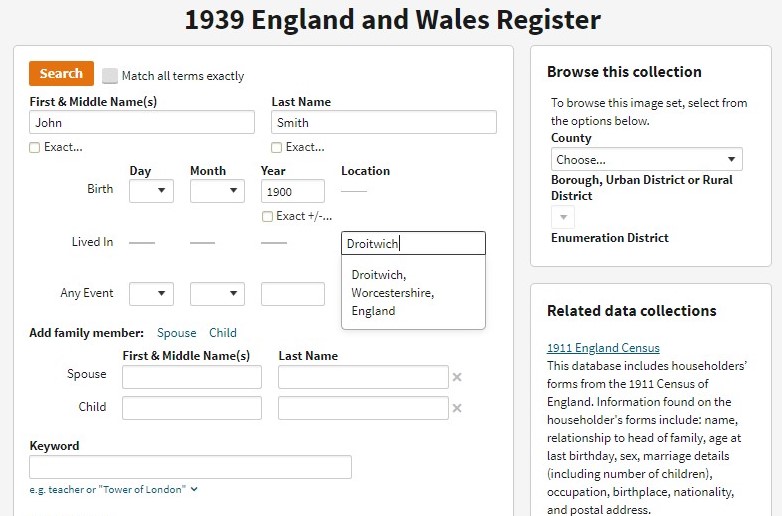
Ancestry search screen

If you’re getting started in researching then download our Research Guide which contains details about lots of different sources, including some which are on the Ancestry website. Go to https://www.explorethepast.co.uk/discover-your-past/ and download it for free.
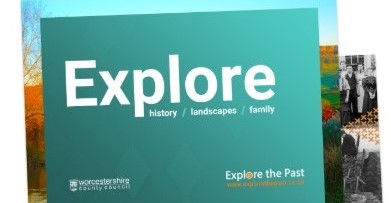
Post a Comment